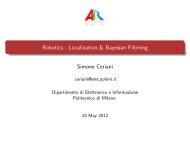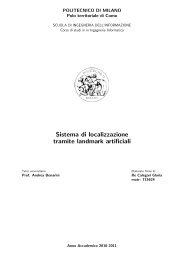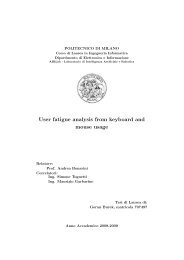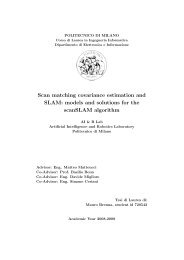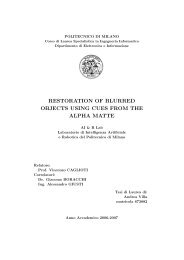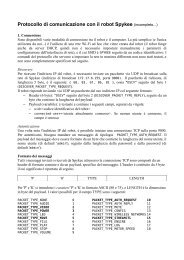Submitted version of the thesis - Airlab, the Artificial Intelligence ...
Submitted version of the thesis - Airlab, the Artificial Intelligence ...
Submitted version of the thesis - Airlab, the Artificial Intelligence ...
You also want an ePaper? Increase the reach of your titles
YUMPU automatically turns print PDFs into web optimized ePapers that Google loves.
2.1. Locomotion 11<br />
Omnidirectional robots that are able to move in any direction (x, y, θ) at<br />
any time are also holonomic. There are two possible omnidirectional configurations.<br />
Thefirstomnidirectional wheel configuration has three omniwheels, each<br />
actuated by one motor, and <strong>the</strong>y are placed in an equilateral triangle as depicted<br />
in Figure 2.7. This concept provides excellent maneuverability and is<br />
simple in design, however, it is limited to flat surfaces and small loads, and<br />
it is quite difficult to find round wheels with high friction coefficients. In<br />
general, <strong>the</strong> ground clearance <strong>of</strong> robots with Swedish and spherical wheels<br />
is somewhat limited due to <strong>the</strong> mechanical constraints <strong>of</strong> constructing omnidirectional<br />
wheels.<br />
Figure 2.7: Palm Pilot Robot with omniwheels<br />
Thesecond omnidirectional wheel configuration has fouromniwheel each<br />
driven by aseparate motor. By varying<strong>the</strong> direction <strong>of</strong> rotation and relative<br />
speeds <strong>of</strong> <strong>the</strong> four wheels, <strong>the</strong> robot can be moved along any trajectory in<br />
<strong>the</strong> plane and, even more impressively, can simultaneously spin around its<br />
vertical axis. For example, when all four wheels spin ’forward’ <strong>the</strong> robot as<br />
a whole moves in a straight line forward. However, when one diagonal pair<br />
<strong>of</strong> wheels is spun in <strong>the</strong> same direction and <strong>the</strong> o<strong>the</strong>r diagonal pair is spun<br />
in <strong>the</strong> opposite direction, <strong>the</strong> robot moves laterally. These omnidirectional<br />
wheel arrangements are not minimal in terms <strong>of</strong> control motors. Even with<br />
all <strong>the</strong> benefits, few holonomic robots have been used by researchers because<br />
<strong>of</strong> <strong>the</strong> problems introduced by <strong>the</strong> complexity <strong>of</strong> <strong>the</strong> mechanical design and<br />
controllability.<br />
In mobile robotics <strong>the</strong> terms omnidirectional, holonomic and non holonomic<br />
are <strong>of</strong>ten used, a discussion <strong>of</strong> <strong>the</strong>ir use will be helpful. Omnidirectional<br />
simply means <strong>the</strong> ability to move in any direction. Because <strong>of</strong> <strong>the</strong><br />
planar nature <strong>of</strong> mobile robots, <strong>the</strong> operational space <strong>the</strong>y occupy contains




